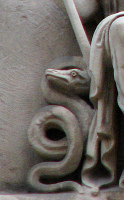
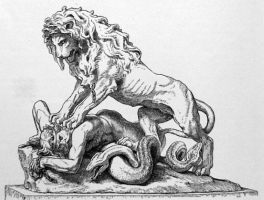
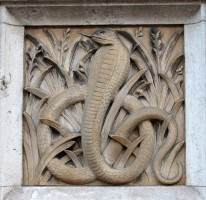
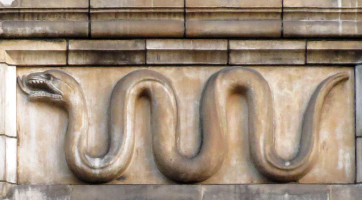
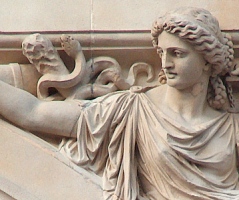
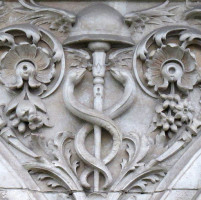
Snake sculpture.
Snakes are fairly frequent in Victorian sculpture, and from other periods. In art generally from medieval times onwards we are most familiar with the innumerable paintings of Eve and the Serpent – hardly an advert for the beast. Thus today we are used to the snake as evocative of treachery, poison or deceit. Yet in sculpture, the snake is used most often as an allegory for positive attributes – in the forms of the staffs of Mercury and Aesculapius, and the Snake of Prudence.
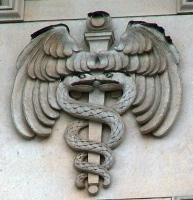
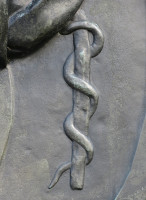 Caduceus and Aesculapian staff.
Caduceus and Aesculapian staff.
The staffs of Mercury and Aesculapius are often casually confused, but are easily distinguished: Mercury (Hermes to the Greeks) carried the Caduceus, which is a staff with two snakes twined round it, facing each other near the top, and often with small wings above this. Aesculapius (Asclepius) carries a staff with a single snake wrapped around it.
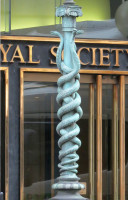
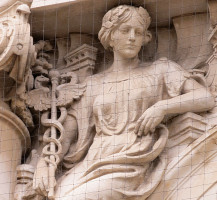
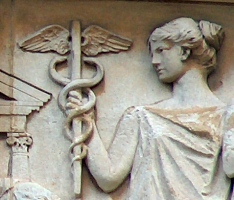
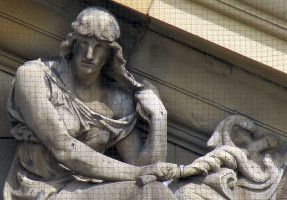 Variations on Mercury's Caduceus.
Variations on Mercury's Caduceus.
Mercury was the messenger of the Gods, and so the Caduceus (two snakes) is often used as a symbol for a messenger or herald, or by extension speedy travel. It may also represent trade and commerce, as these require travel by the merchants between different lands.
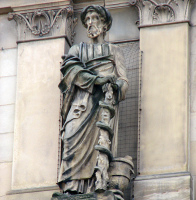 Medicine, with Aesculapian staff
Medicine, with Aesculapian staff
Aesculapius was the Greek god of Medicine and Healing, and in ancient times he would have as his attributes both the snake and a staff, but later depictions bring these together as a snake wrapped round a staff. The Aesculapean staff (one snake), or the snake on its own, is therefore a symbol of healing, and many professional organisations of doctors and surgeons and their kind use it as a symbol. The Caduceus is more symmetrical by virtue of having two snakes, so in modern times is often used, less historically correctly, as a health symbol.
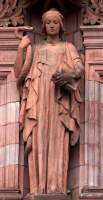
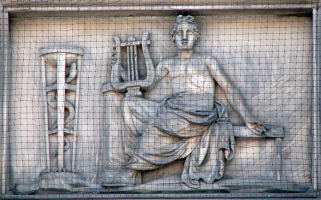 Prudence with a snake, and sculptured panel of Wisdom.
Prudence with a snake, and sculptured panel of Wisdom.
The snake is also associated with Wisdom, and in this capacity is often found with statues of Prudence, most notably in the statues of Prudence on the Prudential Insurance Company, which survive across the country.
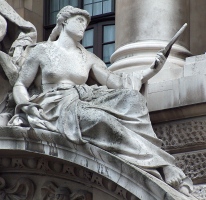
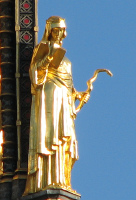 Allegorical sculpture of Truth and Wisdom with snakes.
Allegorical sculpture of Truth and Wisdom with snakes.
In terms of wisdom as clear sight, allegorical figures of Wisdom, or Truth, sometimes come with a snake as an accoutrement, no staff included. The example above left, by the sculptor F. W. Pomeroy, has the snake would round Truth's arm; that on the right by J. F. Redfern has the snake held out in one hand of Wisdom, who reads from a book held in her other hand; another example of Wisdom with a snake, as an Athena, is at the top of this page on the left (click to enlarge to see the figure).
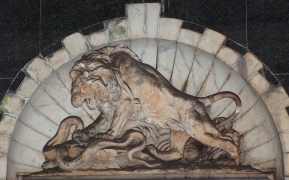
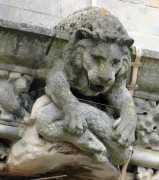 Lions and snakes: Baker Street sculpture on the left.
Lions and snakes: Baker Street sculpture on the left.
Snake sculpture is found in other settings too. As a symbol of Treachery and the Enemy (i.e. from the Christian rather than the Classical tradition), it may be associated with the British Lion (generally with the helpless reptile being crushed underfoot) in war memorials, such as that at Baker Street Station in London, above left. The second example above shows a lion pouncing on a snake, in an architectural setting.
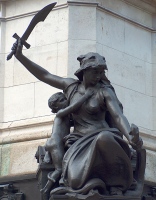
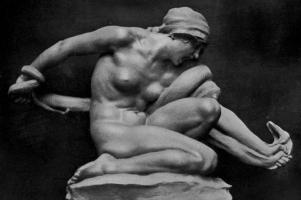 Statues of female figures of Courage fighting snakes.
Statues of female figures of Courage fighting snakes.
Continuing with allegorical figures and the theme of the snake as epitomising the Enemy, figures of Courage may be shown slaying a snake, as in the two figures above. That above left is Hamo Thornycroft's figure of Courage for the Gladstone Monument in the Strand. The nude on the right shows a variation of the same theme.
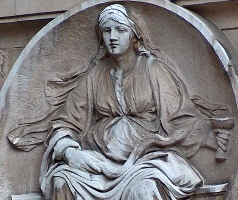
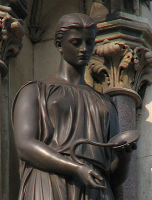 Statues of Health and Medicine, with snakes, no staffs.
Statues of Health and Medicine, with snakes, no staffs.
Statues of Health and Medicine, without an Aesculapian staff or Caduceus, can still incorporate the snake, as in the two examples above.
Examples of snake adornment to sculptured keystone heads, and a roundel head.
We should also mention allegorical keystone heads, where Mercury can be shown with his winged helmet and snakes (see this page if you like keystone heads). Or the snake can be used in other ways, as in the other examples above. The one on the far right has an intriguing snake torc.
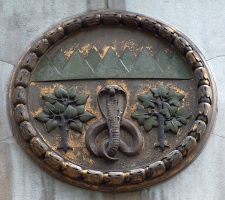
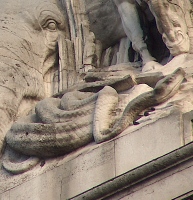 Snake sculpture epitomising places: India (left), and Africa.
Snake sculpture epitomising places: India (left), and Africa.
Moving away from allegory, the Cobra is associated with India, and India House in Aldwych has one on a roundel as part of the architectural decorative sculpture on that building. Nearby, we may note a panoply of carved African animals on Africa House in Kingsway, and the sculptor has seen fit to include an African python as typical of the megafauna of that continent.
Here are two sculptural examples of the nude figure associated with a non-allegorical snake, both entitled The Snake Charmer.
Above are examples of snake sculpture in an architectural setting. From the left, we have hippogryphs with a water snake on a tall building; a large vase with snake handles, this being of ancient origin; a panel with two coupled snakes; and another panel with an architectural Trophy incorporating a pair of snakes. Finally, it would be wrong to have a page on snake sculpture without including an example with winged snakes, as in the endearing case below.
Visits to this page from 4 Jun 2014: 23,117
Animal sculpture // Allegorical sculpture